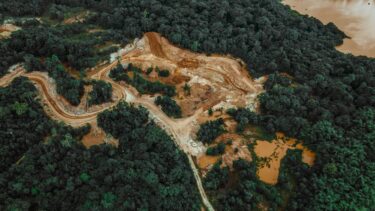
Contents
- Climate & Biodiversity are linked
- Nature Positive as a new term
- Nature Financing will be crucial
- Involve Indigenous communities
- Moving forward
- Contact us
Share this article
‘Natural disasters and extreme weather events’ is the second-most severe risk that the world needs to be prepared for in the next two years. Nature is the next challenge asking for a global solution.
Who would have thought that ‘nature’ and ‘biodiversity’ would be words that sit at the front and centre of many businesses today?
Since the UN Biodiversity COP15 in Montreal ended with a commitment to protect 30% of land and seas by 2030, nature and biodiversity have become part of our common vocabulary. The World Economic Forum (WEF) Global Risks Report 2023 indicates that ‘failure to mitigate climate change’ as well as ‘failure of climate change adaptation’ are the two most severe risks facing the world in the next decade, followed by ‘natural disasters and extreme weather events’ and ‘biodiversity loss and ecosystem collapse’.
COP15, the United Nations Convention on Biological Diversity, culminated in a new Global Biodiversity Framework to 2030. There were 23 targets agreed upon which require broad based action towards a transformation in our societies’ relationship with biodiversity by 2030, and ensure that, by 2050, the shared vision of living in harmony with nature is fulfilled. These 23 targets are in line with the 2030 Agenda for Sustainable Development and its Sustainable Development Goals.
Four key takeaways
1. Climate and biodiversity are linked crises
Both from a climate change adaptation and mitigation perspective, nature provides solutions. 37% of the climate mitigation needed to stick to the 1.5 degree global warming goal can be provided by Natural Climate Solutions. A strong example of this is supporting farmers in South America towards a more holistic grazing practice amongst others aiming at the return of endemic species. Many climate adaptation measures – for example, protection against flooding due to rising sea levels – are also provided by nature. At the same time, biodiversity is severely impacted by climate change, and the damage to nature is expected to become more severe as climate change worsens. Protecting and restoring nature can help to mitigate climate change, while also protecting humans.
The Global Biodiversity Framework commitment is to protect 30% of land and seas by 2030.
2. Nature Positive as a new term
It was acknowledged that we need to halt and reverse nature loss by 2030 – which is also referred to as taking a Nature Positive approach. This is an equivalent to the 1.5 degree goal for climate change. The Global Biodiversity Framework commitment is to protect 30% of land and seas by 2030. To get there we need to take action, and 23 targets were agreed upon to do this. Key targets are:
- Agreement that commits governments to requiring all large business and financial institutions to assess and disclose their risks, impacts and dependencies on biodiversity at the latest by 2030 (Target 15). The dependency lens especially will drive and motivate businesses to recognise how much they rely on nature.
- Promises for a comprehensive reform of environmentally harmful subsidies by redirecting or eliminating them (Target 18), with a target of $500 billion per year of reduction. This is a real step forward compared to the previous 2010 Aichi target.
3. Nature Financing will be crucial
As with COP27, the climate COP in Egypt earlier in 2022, financing is crucial to drive action. For biodiversity, $700 billion in financing needs to be provided every year to tackle the global nature crisis. This is principally a financial flow from richer to poorer countries. It is clear that the cost of inaction is much larger.
Several additional initiatives which finance nature were announced during COP15, including:
- Nature Action 100, a global investor engagement initiative focused on driving greater corporate ambition and action to reduce nature and biodiversity loss.
- Kering and L’Occitane’s initiative, which showed the importance of cross-sector collaboration by announcing new finance for nature-based solutions that will mobilise resources from luxury fashion and the beauty sector. The Climate Fund for Nature, targeted to reach €300m, is specially designed to invest in nature-based solutions in countries where they source their raw materials. Projects will include reforestation, mangrove restoration and protecting grassland from overgrazing.
4. Involve Indigenous communities
It was acknowledged that the role of Indigenous people is key to the protection and restoration of nature (Target 22). In addition to what we can learn from Indigenous people about living in balance with nature, at least 80% of the planet’s remaining biodiversity is cared for by their communities. Target 3 recognises and respects the rights of Indigenous peoples and local communities, including their rights over their traditional territories.
Moving forward
Progress was certainly made at COP15 – but there are still some concerns moving forward.
The first concern is around another crisis – the water crisis. Shouldn’t we be tackling the climate, biodiversity, and water crises as one? We have an opportunity to do so with the UN2023 Water Conference coming up in March in New York. This will be the first global conference on water in 46 years! These environmental crises cannot be treated in silos.
A second concern is that the agreements which were reached at COP15 are not legally binding. We believe, however, that the commitments made by leading businesses through Business for Nature and the Capitals Coalition and the fact that the largest contingent of businesses ever was present at this COP mean that we will move towards a nature positive 2030. We continue to hope that these agreements will be turned into legally binding commitments by governments, for the future of our planet.
We are the world’s leading purpose driven, digitally enabled, science-based activator. And always welcome inquiries and partnerships to drive positive change together.




